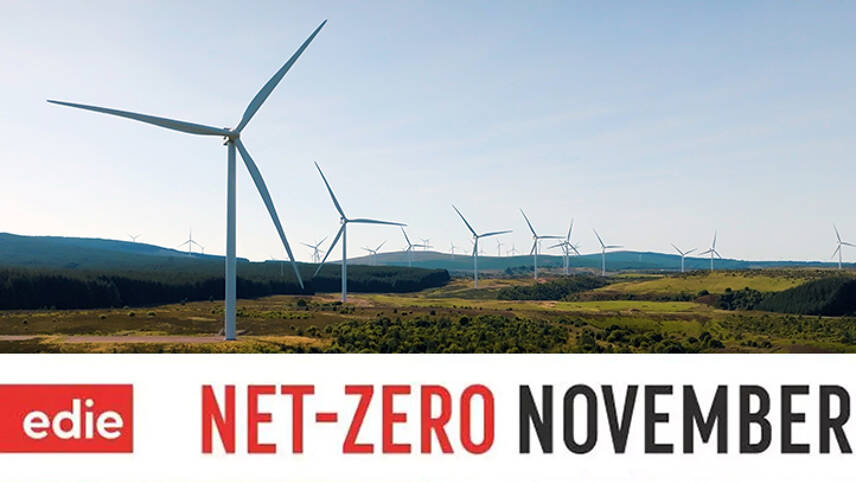This premium content is exclusive to edie Members.
To find out more about edie Membership, please click below.
If you are an existing member, login here

In September 2023, Kimberly-Clark unveiled a collaboration with Octopus Renewables Infrastructure Trust (ORIT) to establish an onshore windfarm. This strategic move is set to propel the company toward its goal of sourcing a considerable 80% renewable energy for its UK operations, encompassing sites such as the Barrow, Flint and Northfleet manufacturing facilities.
Renewables forms a key part of Kimberly-Clark’s, the parent company of household brands Andrex, Kleenex and Huggies, targets to decrease its total greenhouse gas (GHG) emissions. The targets include a 50% reduction for Scope 1 & 2 emissions and a 20% reduction for Scope 3 emissions (Categories 1 & 12) by the year 2030.
Behind the scenes of Kimberly-Clark’s wind power preference
Nestled in the landscapes of South Lanarkshire, the £75m Scottish windfarm boasts 12 turbines with a combined capacity of 50 megawatts (MW), making it the largest asset in ORIT’s wind portfolio.
While wind power offers a sustainable path to decarbonising a company’s energy consumption, it is not without its hurdles. These challenges encompass cost competitiveness, grid interconnection capacity and potential environmental and wildlife impacts.
This leads to the question — why, among the array of renewable energy alternatives, has Kimberly-Clark made the deliberate choice to embrace wind power.
“We at Kimberly-Clark have a specific requirement and what we are looking for is to deploy renewable energy in a way that fits us better,” says Oriol Margo, Kimberly-Clark’s EMEA sustainability transformation leader.
Oriol explains that Kimberly-Clark operates with a 24/7 consumption profile, and he believes that wind power is a better match for this continuous energy demand.
In the recent PPA case, Kimberly-Clark initiated a tender process, assessing solar and wind projects. They actively interacted with UK projects, aiming to identify those ready to proceed, even if hindered by funding constraints or the need for long-term corporate support.
After a comprehensive assessment of all these projects, taking into account factors like readiness and viability, the ORIT’s windfarm project ranked at the top of Kimberly-Clark’s list.
However, despite the seemingly straightforward nature of the process, Oriol clarifies that it was anything but.
Navigating challenges on the wind power path
Oriol elaborates that in the context of decarbonising operations and making substantial investments, such as the £75m commitment from Octopus to the windfarm project, the necessity for a long-term commitment becomes evident.
This long-term commitment is essential as it enables the unlocking of funding and facilitates access to financial support from investors. Nevertheless, embracing a long-term commitment also entails grappling with the uncertainties of the future.
Oriol says: “With long term contracts, it is difficult to know what will happen in the future. There is always a bit of risk and difficulties.
Oriol suggests that, given the uncertainty of the future, the most prudent approach is to analyse one’s perception of what the future may hold, examine proposed solutions, and proceed with sustainable projects.
He adds: “What we do know is that consumers will want that, and they will demand more of it.”
In 2022, the global manufacturer made considerable strides by achieving a 42% absolute reduction in its GHG emissions and improving energy efficiency by 9.4% compared to its 2015 baseline.
This progress equates to a reduction of 65,000 metric tons of CO2 equivalent (MTCO2e) emissions in one year. To put this in perspective, it’s equivalent to the annual CO2 emissions generated by the electricity consumption of 12,600 typical households in the US.
Moreover, with the recent inclusion of the Scottish windfarm in its energy procurement portfolio, Kimberly-Clark will be to achieve an additional annual emissions reduction of 55,625 MTCO2e. This is akin to removing 38,628 passenger vehicles from the road every year.
Kimberly-Clark explores alternative renewables
As Kimberly-Clark intensifies its efforts to expedite the implementation of wind power at its manufacturing facilities as part of its net-zero strategy, the company is concurrently exploring a range of other renewable options.
This includes the incorporation of solar and green hydrogen, with the aim of broadening its portfolio of decarbonised energy sources and better serving an expanding consumer base.
Last year, Kimberly-Clark signed an agreement with Carlton Power to support the development of a 35MW electrolyser in Cumbria for hydrogen production. Earlier this year, the project secured a place on the UK Government’s Hydrogen Business Model Strategy Shortlist, and it is now expected to become operational by the end of the year.
The company is also actively pursuing the acquisition of green hydrogen to meet the energy needs of its manufacturing sites in Northfleet, Kent and Flint, North Wales.
At present, Kimberly-Clark relies on natural gas for 60% of its electricity consumption, and Oriol explains that the process of decarbonising this aspect of their energy usage is ‘quite complex’.
Should the green hydrogen initiatives prove successful, they are anticipated to commence green hydrogen production by 2025, effectively reducing carbon emissions by more than 50% across the sites’ thermal processes.
The Cumbria project alone is projected to result in a 30% reduction in the brand’s total reliance on natural gas for manufacturing in the UK and Ireland.
Looking ahead
With numerous renewable energy projects already in the pipelines, it is evident that Kimberly-Clark is actively pursuing a transformation into a sustainable business.
The company is diligently laying the foundation, making steadfast commitments to decarbonise and significantly reduce its carbon footprint.
“We are building the needs for our consumers of not only today but in 10 years’ time as well. We need to look at the future consumers because we do think that sustainability is going to be more and more important for them,” concludes Oriol.


Please login or Register to leave a comment.